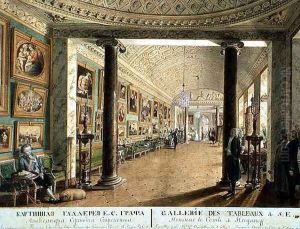Andrei Nikiforovich Voronikhin Paintings
Andrei Nikiforovich Voronikhin was a prominent Russian architect and painter, widely recognized for his significant contribution to Russian neoclassicism. Born on November 28, 1759, in the village of Pustomazovo, he was originally a serf belonging to Count Stroganov. Voronikhin's talent was recognized early on, and he was allowed to study art and architecture, largely due to the support of his owner, who was an enlightened patron of the arts.
In 1777, Voronikhin was sent to St. Petersburg, where he studied at the Academy of Arts under the tutelage of the French architect Charles de Wailly. His studies were comprehensive, including painting, sculpture, and architecture. Voronikhin was emancipated from serfdom in 1785 and continued his studies abroad in Europe, where he was greatly influenced by the neoclassical movement. After returning to Russia in the 1790s, he began his architectural career, contributing to the design and construction of many significant structures.
A crowning achievement in Voronikhin's architectural career was the design and construction of the Kazan Cathedral in St. Petersburg. The cathedral, which was commissioned by Emperor Paul I, is famed for its grand colonnade and was inspired by St. Peter’s Basilica in Rome. His other notable works include the Mining Institute, also in St. Petersburg, and the interiors of the Stroganov Palace. Voronikhin also contributed to urban planning and was involved in designing the layout of streets and squares in St. Petersburg, thus leaving a lasting impact on the city's architectural landscape.
Andrei Nikiforovich Voronikhin died on September 6, 1814, in St. Petersburg. His legacy lives on in his architectural masterpieces, which continue to be studied and admired for their elegance and historical significance within the context of Russian culture and neoclassical architecture.
